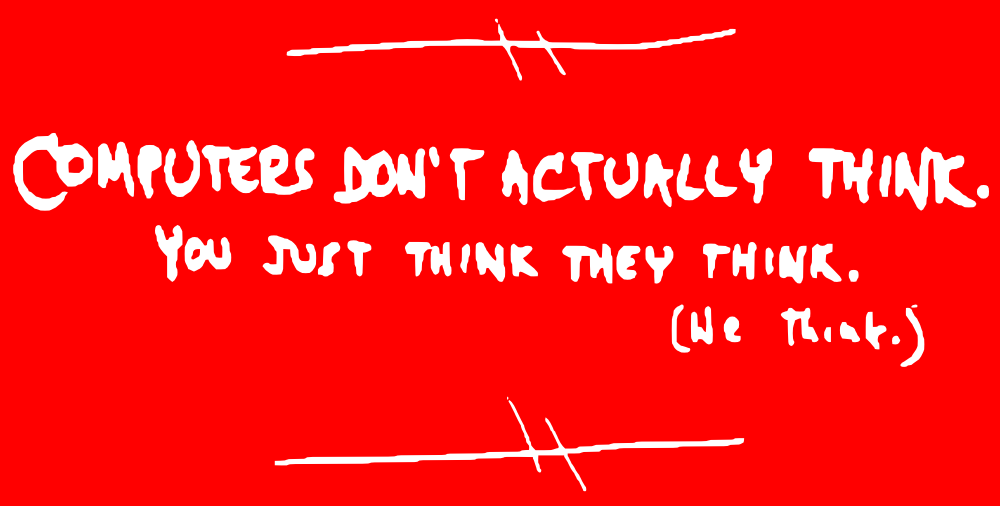From time to time, 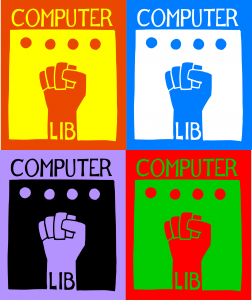 I’ve posted snippets from Ted Nelson’s 1974 book(s) Computer Lib / Dream Machines on various social networks but, now it’s fifty years old, it seems like a good moment to pull together some of the eye-catching quotations and reflect on the book(s) a little.
I’ve posted snippets from Ted Nelson’s 1974 book(s) Computer Lib / Dream Machines on various social networks but, now it’s fifty years old, it seems like a good moment to pull together some of the eye-catching quotations and reflect on the book(s) a little.
Who is Ted Nelson, and why does a fifty-year-old book on computing matter today? Ted Nelson is probably best-known as the man behind Xanadu, a wildly ambitious hypertext system he first described in the 1960s and has been tinkering with ever since. In a 1995 article, Wired magazine called it ‘the longest-running vapourware project in the history of computing.’ As far as I know, almost thirty years later, it still hasn’t shipped (although Ted Nelson is still alive.)
Computer Lib / Dream Machines is, even by the standards of its age, an odd book. Self-published by Nelson in 1974, its appearance is shambolic but oddly charming, like a samizdat political pamphlet or fanzine. Its hand-drawn headlines, type-written text at odd angles is reminiscent of early editions of the British satirical magazine Private Eye. It is, in fact, two books in one. Which book you started reading depending on which way you picked it up, as they were printed back to back.
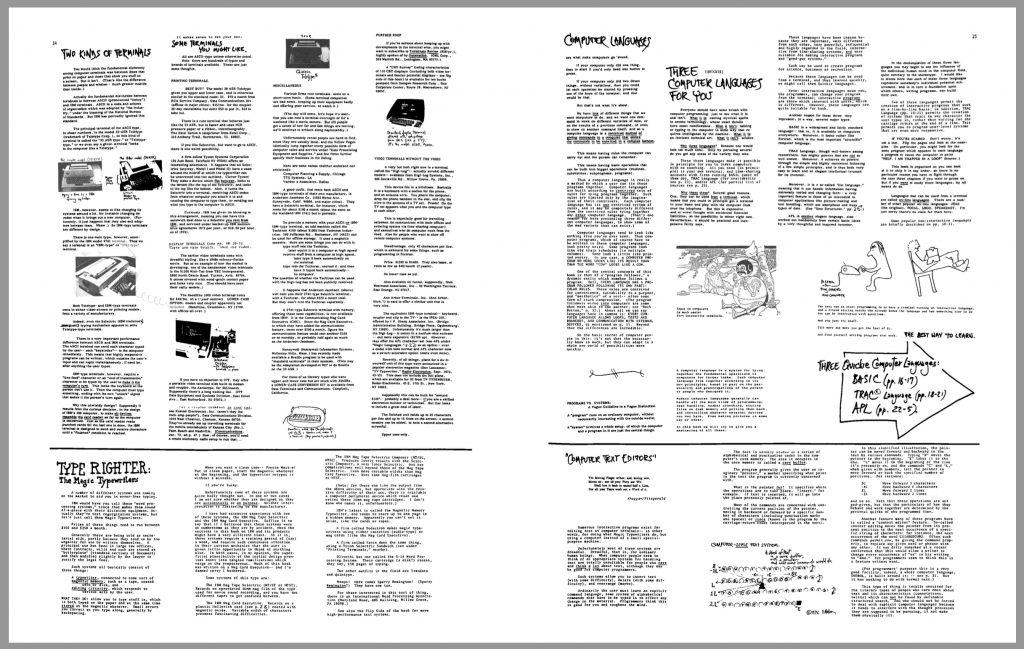
Computer Lib is more of a political or social manifesto, a treatise on what computing had become whereas Dream Machines looks ahead to what computing could become, focusing on computers as machines for manipulating and creating visual arts and writing.
Both books are fascinating, partly as a snapshot of computing history immediately before the microcomputer revolution (which Nelson saw coming), but also because so much of it still seems relevant today. Much of what he says about the social impact of computing is relevant to today’s AI mania, and he even explicitly discusses AI, then in its infancy, in ways that I think we would do well to be mindful of.
Here’s Ted on ‘cybercrud’ – using computing as a ‘smoke and mirrors’ term to hide ulterior motives. Replace ‘computer’ or ‘cyber’ with ‘AI’ as you read it:
CYBERCRUD.
A number of people have gotten mad at me for coining the term “cybercrud,” which I define as “putting things over on people using computers.”
But as long as it goes on we’ll need the word. At every corner of our society, people are issuing pronouncements and making other people do things and saying it’s because of the computer. The function of cybercrud is thus to confuse, intimidate or pressure. We have all got to get wise to this if it is going to be curtailed.
Cybercrud lakes numerous forms. All of them, however, share the patina of “science” that computers have for the layman.
1a) COMPUTER AS MAGIC WORD
The most delicate, and seemingly innocent, technique is the practice of naming things so as spuriously to suggest that they involve computers. Thus there ls a manufacturer of pot-pipes with “Data” in its name, and apparently a pornography house with a “Cyber-”
…
2) WHITE LIES: THE COMPUTER MADE ME DO IT
Next come all the leetle white Lies about how such-and-such is the computer’s fault and not your decision. Thus the computer is made a General Scapegoat at the same time it’s covering up for what somebody wants to do anyway.
“It has to be this way.”
“There’s nothing we can do; this is all handled by computer.”
“The computer will not allow this.”
“The computer won’t let us.”
The translation is, of course, THE STINKY LOUSY PROGRAM DOES NOT PERMIT IT. Which means in turn: WE DO NOT CHOOSE TO PROVIDE, IN OUR PROGRAMS AND EQUIPMENT, ANY ALTERNATIVES.
Now, it is often the case that good and sufficient reason exist for the way things are done. But it is also often the case that companies and the public are inconvenienced, or worse, by decisions the computer people make and then hide with their claim of technical necessity.
(Computer Lib, p8)
Sometimes the stand-out anecdotes are just sweet. This story about children interacting with computing resonates with me deeply:
I know a high-school boy (not a computer expert) who programmed a computer to type out a love story, using the BASIC “print” command, the only one he knew. He could not bring himself to write the love story on paper.
The best example I can think of, though, look place at the kids’ booth at a computer conference. One of the more withdrawn girls was sitting at an off-line video terminal, idly typing things onto the screen. When she had gone a sentence remained. It said:
I love you all. but at a distance.
|—————————————————|
(Computer Lib, p9)
This next idea is also intriguing – that computers need not have been named after humans who carried out mathematical operations. They could have been called something else:
THE ALL-PURPOSE MACHINE
Computers are COMPLETELY GENERAL, with no fixed purpose or style of operation. In spite of this, the strange myth has evolved that computers are somehow “mathematical.” Actually von Neumann, who got the general idea about as soon as anybody (1940s), called the computer THE ALL-PURPOSE MACHINE. (Indeed, the first backer of computers after World War II was a maker of multi-lightbulb signs. It is an interesting possibility that if he had not been killed in an airplane crash, computers would have been seen first as text-handling and picture-making machines, and only later developed for mathematics and business.)
We would call it the All-Purpose Machine here, except that for historical reasons it has been slapped with the other name.
But that doesn’t mean it has a fixed way of operating. On the contrary, COMPUTERS HAVE NO NATURE AND NO CHARACTER, save that which has been put into them by whoever is creating the program for a particular purpose. Computers are, unlike any other piece of equipment, perfectly BLANK. And that is how we have projected on it so many different faces.
(Computer Lib, p10)
Perhaps we would do well to remember that AI systems, even generative AI systems, are also perfectly BLANK until trained – by humans.
Nelson offers this ‘helpful comparison’:
A HELPFUL COMPARISON.
It helps sometimes to compare computers with typewriters.
Both handle information according to somebody’s own viewpoint
Nervous Question: “Can a Computer Write a Poem?”
Helpful Parallel: “Can a Typewriter Write a Poem?”
(Sure. Your poem.)“Can’t Computers Only Behave Mechanistically?”
“Can’t Typewriters Only Behave Mechanistically?”
(Yes, but carrying out your intent.)“Aren’t Computers Completely Impersonal?”
“Aren’t Typewriters Completely Impersonal?”
(Well, it’s not like handwriting, but it’s still what you say.)
(Computer Lib, p10)
What might a helpful comparison for AI look like?
Nervous Question: “Can AI Write a Poem?”
Helpful Parallel: “Can a computer Write a Poem?”
(Sure. A poem trained on poetry written by the programmer or other internet-connected humans.)
Nervous Question: “Can’t AI Only Behave Mechanistically?”
Helpful Parallel: “Can’t Computers Only Behave Mechanistically?”
(Yes, but carrying out the designer’s intent.)
Nervous Question: “Isn’t AI Completely Impersonal?”
Helpful Parallel: “Aren’t Computers Completely Impersonal?”
(Well, it’s not your thoughts, but it’s still what other humans might say.)
In Dream Machines Nelson tackles AI head on. I think this stands up pretty well for something written fifty years ago.
THE GOD-BUILDERS!
ARTIFICIAL INTELLIGENCE… sort of
“Artificial Intelligence” is at once the sexiest and most ominous term in the world. It chills and impresses at the same time. In principle it means the simulation of processes of mind, by any means at all; but it generally turn out to be some form or another of computer simulation.
Actually, “artificial intelligence” has generally become an all-inclusive term for systems that amaze, astound, mystify, and do not operate according to principles which can be easily explained. In a way, “artificial Intelligence” is an ever-receding frontier: as technique become well-worked out and understood, their appearance of intelligence, to the sophisticated, continually recedes. It’s like the ocean: however much you take out of it, it still stretched on — as limitless as before.
Unfortunately laymen are so impressed by computers in general that they easily suppose computers can do anything Involving information. And public understanding is not fostered by certain types of stupid demonstration. One year I heard from numerous people about how “they’d seen on TV about how computers write TV scripts”- what had actually been shown was a hokey enactment of how the computer could randomly decide whether the Bad Man get shot or the Good Guy gets shot — both outcomes dutifully enacted by guys in cowboy outfits. Duh.
(Dream Machines, p12)
Computers don’t actually think.
You just think they think.
(We think).
(Dream Machines, p12)
Thinking about AI was not new in 1974, but the field was about to enter one of its ‘winters’ where innovation stalled, which makes Nelson’s timeline of AI past, present and future fascinating to read today. Can someone tell me, are we at ‘sexy unknown’ or ‘El Beyondo’ now?
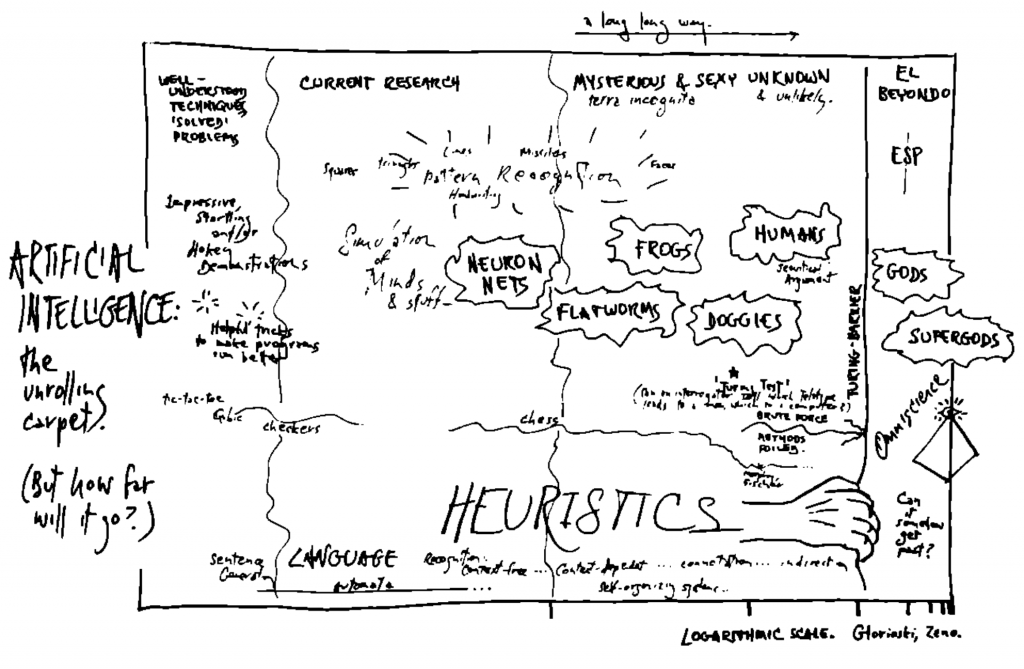
Just as early 1970s computing magazines like People’s Computer Company / Dr Dobb’s Journal are full of things that are unexpectedly relevant today, Ted Nelson’s Computer Lib / Dream Machines is full of nuggets that make me wonder what the world would have been like if he’d been more listened-to, and indeed more successful.
In a similar vein, of paths not taken, I commend this 2013 video, imagining what a talk on the future of programming given in 1973 might have looked like:
Has Computer Lib / Dream Machines really aged well? Well, no. There’s plenty of sexism in there. There’s language that we would not tolerate today, although its context justifies at least reading it today, if not re-posting it. But I guarantee that if you have any interest in the social impact of digital technology, or just its history especially in the creative arts, if you scroll through it, you will find something to surprise or interest you. There’s a lot on cathode ray tubes, for example. CRTs are now obsolete technology, but I read Ted Nelson with a tinge of regret at what we’ve lost: light pens and vector graphics, purer than any blocky, pixellated bitmap rendition of a geometric shape.
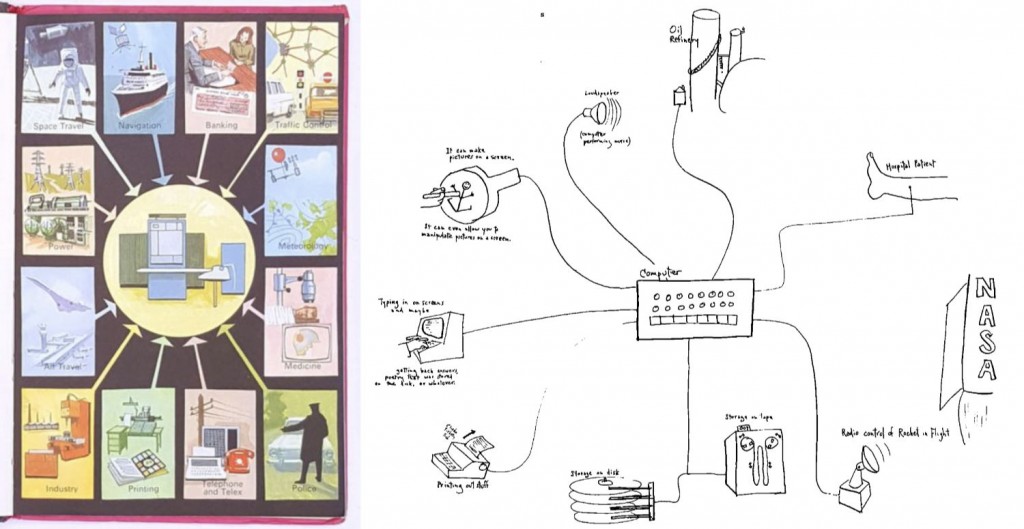
1971 Ladybird book on computers (left) and a diagram from Computer Lib (1974) that reminded me of it.
Useful links
Computer Lib / Dream Machines at the Internet Archive: https://archive.org/details/computer-lib-dream-machines/page/n93/mode/2up
The Curse of Xanadu, Wired magazine, 1 June 1995: https://www.wired.com/1995/06/xanadu/
How it Works: The Computer (Ladybird Books, 1971) at the Internet Archive: https://archive.org/details/How.It.Works.The.Computer.1971.Edition.David.Carey/page/n39/mode/2up
People’s Computer Company / Dr Dobb’s Journal magazines at the Internet Archive: https://archive.org/search?query=creator%3A%22People%27s+Computer+Company%22


